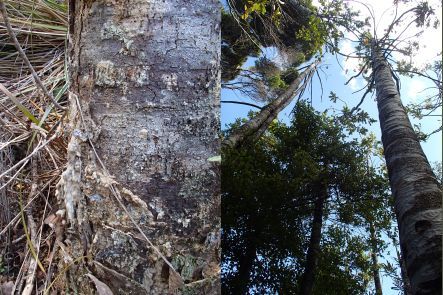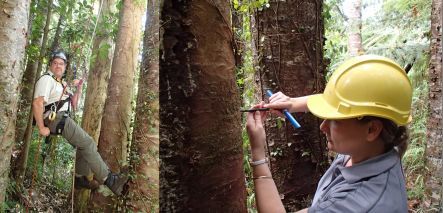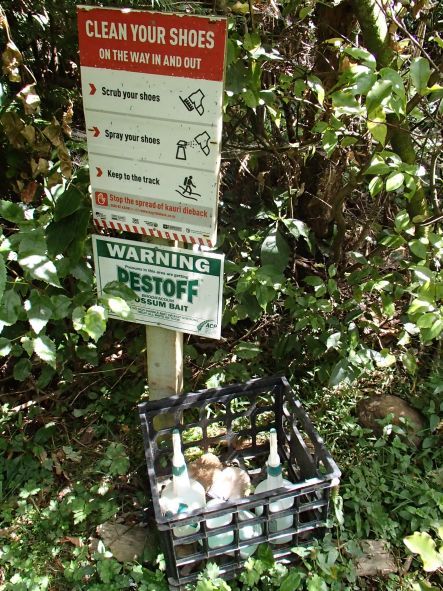Five years ago a new plant disease was identified in New Zealand – Phytophthora taxon Agathis, also known as PTA, or kauri dieback disease, which infects and kills giant native kauri trees (Agathis australis). The effects of kauri dieback disease were first noticed 40 years ago in a stand of trees on Great Barrier Island, but the organism was wrongly identified as another species of Phytophthora and it wasn’t until the mid-2000s that the late Ross Beever realised that organism was actually PTA. There is no cure and no vaccination for PTA, which is found only in New Zealand and infects only kauri trees.

Oozing sap, or gumosis, at the base of the trunk (left) is a sign a kauri tree is infected with kauri dieback, as is the bare canopy of the trees to the right (images: A. Ballance)
PTA is a water-borne Chromista or water mould, belonging to a group of organisms known as Oomycota, which are relatives of fungi. Its spores infect the roots and base of kauri trees, which produce large amounts of sap in response – this gum and canopy dieback are the main diagnostic signs of an infection. Over several years large kauri trees are gradually ‘ringbarked’ by the disease and gradually die. In the last decade kauri dieback disease has become widespread in west Auckland, the Waitakere Ranges and the great kauri forests of Northland. It is still absent from the Coromandel Peninsula, the Hunua ranges and Waiheke Island.
The official kauri dieback programme began in October 2009, a year and a half after PTA was identified as a new disease. It received funding for 5 years of research and management. The kauri dieback programme is a joint agency response that involves the Ministry of Primary Industries, Department of Conservation, Auckland Council, tangata whenua, and Northland, Waikato and Bay of Plenty Regional Councils. Its main message to the public is to protect kauri by cleaning gear and staying on tracks in the forest.
In this Our Changing World special feature Alison Ballance visits a number of places and people to find out about the disease and its impact. At Colin McCahon House in Titirangi, where the late Colin McCahon painted nearly 50 works with kauri in the title, Diane Blomfield and Chris McBride share their experience with the disease, which saw two trees on the property felled in January 2013.

Diane Blomfield, Chris McBride and Nick Waipara in front of one of the standing kauri trees in the garden of Colin McCahon House. The log (right) was a kauri tree in the garden that had died from kauri dieback disease and was felled in January 2013 for safety reasons (images: A. Ballance)
Nick Waipara, principal advisor biosecurity at the Auckland Council, describes the disease, which is a relative of the Phytophthora species which caused the great Irish potato famine as well as P. cinnamomi which affects more than 40% of native forest species in Australia and is having a devastating effect on forests there. Nick also discusses how little we know about the disease, and what areas of future research should be funded.
In the Waitakere ranges University of Auckland ecologists Bruce Burns and George Perry are establishing long-term monitoring plots to study the impact of kauri deaths on forest structure. Luitgard Schwendenmann is also beginning long-term work that will look at the impacts of kauri death on carbon storage and litter fall in forests.

A healthy kauri tree (left) in the Waitakere Ranges, and Bruce Burns and George Perry next to a dead kauri ricker in the forest above Piha (images: A. Ballance)
Stanley Bellgard at Landcare Research carries out diagnostic work to identify the PTA – this is a slow process that involves ‘baiting’ the spores to plant material.
Monique Wheat was employed by Auckland Council to find out if PTA was present in the leaves and high trunk of kauri trees, or just at the base and in the roots.

Tree climber Grant descends after collecting wood and leaf samples from high up a dying kauri tree, and Monique Wheat takes a core sample from another dying tree (images: A. Ballance)
Ian Horner from Plant and Food Research is trialling phosphite injections in trees to see if this slows infections – phosphite is used as a treatment in avocado orchards infected by Phytophthora (whose name means plant destroyer). Some landowners are also trialling beneficial soil fungi such as Trichoderma to see if this helps slow the disease.
Arborists Martin Herbert and Matthew Priestley from Treescape are often called in to fell kauri trees that have died from PTA and they explain how PTA impacts their work.
Funding for the kauri dieback programme ends in 2014, and Auckland Council is currently lobbying central government in an effort to secure further funding. In the meantime everyone involved with PTA has one clear message for the public: always clean footwear and gear with Trigene when you enter and leave kauri forests, and please stay on the track to avoid spreading the disease in soil on your boots.


